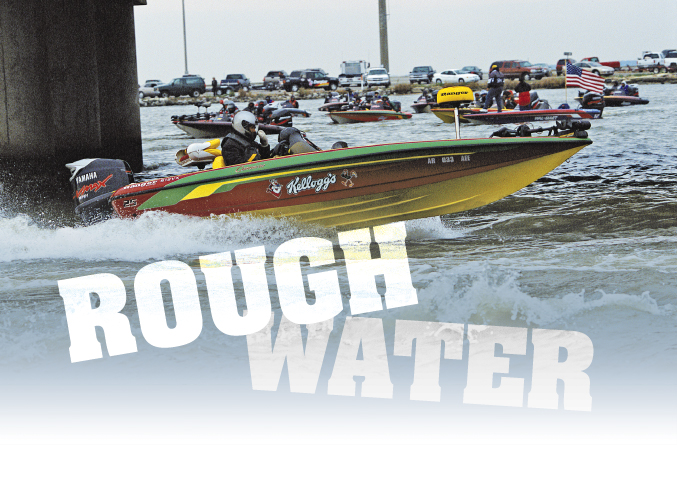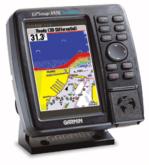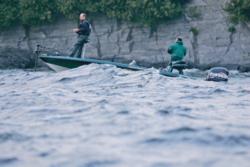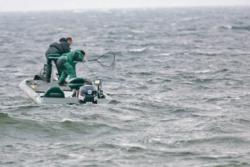Rough water
Learn to navigate rough water safely

Every tournament angler must run on rough water from time to time. How you fare depends on your boat’s design, how your boat is rigged, and, of course, your driving skill. If you fall short in any of these areas, you’ll suffer an unnecessary beating. In swells taller than 4 feet or so, a bad move could have you swimming for your life.
Michigan angler Joe Balog regularly competes in bass tournaments on the Great Lakes and has been caught in seas that would unnerve Capt. Ahab. Even waves as high as 7 feet won’t stop Balog from running to his fish, provided he can reach them in a reasonable amount of time given the crawl speed it takes to navigate such formidable water.
Years of trial and error have taught Balog what it takes to overcome rough water safely and with the least discomfort. You’d be wise to heed what he’s learned. It could possibly save your hide.
Soon after Balog won the 2001 EverStart Series Championship on Pickwick Lake, he did something he had been longing to do for years, he switched to a Ranger Boat. Prior to his first Ranger, Balog went through five different boats in five years. Every one of them suffered damage due to pounding water, and none had storage compartments that could keep his gear dry.
“Every time I fished a tournament on the Great Lakes, the guys who were consistently passing me were running Rangers,” Balog said. “Their boats held up and their compartments stayed drier.”
Today, Balog’s personal boat is a 20-foot, 9-inch, model 520 Ranger, which features increased bow flare to smooth the ride. Soft Ride Seats take the sting out of hard waves, while two 1,000-gallons-per-hour bilge pumps quickly gush out any water that may wash in over the bow or sides.
“Another reason the 520 does so well on rough water is because its cockpit is farther forward than on most other bass boats,” Balog said.
He claims that the 520’s more forward center of gravity reduces the bow’s tendency to lift when it hits a wave. If a boat’s bow rises too high, it falls after it climbs over the crest and spears the next wave. A wall of water washes over the passengers and fills the boat like a bathtub.
The 520’s bow reduces the chance for this common mishap by carving through waves instead of climbing over them. The result is a more level ride that requires less throttle manipulation.
“You want to keep bow lift to a minimum,” Balog said. “The more the bow goes up and down, the more the waves are in control.”
Rigging for rough water
A foot throttle is Balog’s first priority when he rigs a boat for rough water. This device lets him keep both hands on the steering wheel at all times and is more responsive than a hand throttle. Instant throttle adjustments are critical if you are to stay out of trouble in big waves.
“If your boat didn’t come equipped with trim controls on or near the steering wheel, have them installed so you don’t have to reach for the shift lever while you’re driving,” Balog said.
Next on Balog’s list is a four- or five-bladed outboard propeller. Such props usually sacrifice some top end speed, but they are less likely to lose their grip at low speeds than a three-bladed prop. Anytime your boat slowly labors up a wave, it is essentially performing a hole shot. If the prop blows out at this crucial moment, you could be in trouble.
 The Garmin 188C chartplotter/graph combo on Balog’s console also helps him drive in rough water. “I can quickly glance at the screen to make sure I’m on the right heading,” he said. “Before I got a chartplotter, I had to look around for landmarks while I was driving. That’s usually when I’d spear a wave.”
The Garmin 188C chartplotter/graph combo on Balog’s console also helps him drive in rough water. “I can quickly glance at the screen to make sure I’m on the right heading,” he said. “Before I got a chartplotter, I had to look around for landmarks while I was driving. That’s usually when I’d spear a wave.”
Because the stern of a boat doesn’t bounce as much as its bow, Balog stores the anchor, tool box, spare prop and other heavy objects in the bilge area or rear compartments. If a heavy object is placed in a forward compartment, it lurches about and may cause damage. Before he began running Rangers, Balog once had a battery smash through a bow compartment and down into the hull cavity.
“Everything has to be battened down,” Balog said. “I support my electric motor shaft with a RAM mount and add two hold-down straps to backup the one that comes with the motor. Make sure your battery boxes are bolted in place and that the batteries are strapped down.”
Balog always fills his gas tank to full capacity before venturing onto big water, even when he only plans to go a short distance. Running in big waves consumes two to three times as much gas as when you’re zipping over flat water.
Safety gear
Of course, Balog carries all mandatory safety equipment, including personal PFDs, a distress flag and flares that are up to date. His 18-pound Richter claw anchor is connected to 200 feet of rope.
“A lot of guys don’t think of an anchor as a safety device,” Balog said. “But if your boat breaks down in 5-foot waves, an electric motor is useless. If you don’t have a capable anchor and a long rope, your boat may wind up getting smashed to bits on a rocky shoreline.”
No matter how well you drive, your boat is going to take on water (boat spray at the minimum) when waves get much bigger than 3 feet. If your bilge pumps fail, you are in trouble. Balog carries spare bilge pump cartridges, and a spare bilge pump rigged with 6 foot wires connected to alligator clamps, plus a 6 foot hose. In a pinch, he can connect the spare bilge pump directly to one of his batteries and hang the hose over the side of the boat.
It’s hard to imagine any experienced tournament fisherman leaving the dock without sturdy, capable rain gear. Even on sunny days, boat spray will soak you to the bone if you try to traverse rough water without this essential apparel.
Balog adds a fog-proof snowmobile helmet to his rough water attire. It helps him see where he’s going and prevents water from running down the neck of his rain jacket. The helmet also gives him a psychological edge by reducing the sounds of the outboard, the pounding hull and the wind and spray.
“That helmet is the best thing I’ve ever bought,” Balog said. “When I take it off after I get to my fishing spot, I feel relaxed and ready to fish. When I make a hard run without the helmet, I’m so pumped up from driving the boat that I have trouble gearing down to fish.”
The first rule for driving on rough water is to tuck the outboard’s lower unit in. This forces the bow to stay down and slice through waves rather than lift over them. Balog trims his outboard all the way down, or nearly so, whenever waves threaten.
“You can generally run on plane in waves up to about 2 feet, as long as you slow down to 40 to 50 mph to keep the prop from blowing out of the water,” Balog said.
In waves taller than 2 feet, you must slow down even more and negotiate every wave. If you look away for an instant, you’re asking to take one over the bow.
“When you’re running against the waves, you have to throttle up them and let off coming down,” Balog said. “If you are going with the waves, you have to throttle way back even more when you drop down or you’ll nose the next wave.”
If he has to navigate into waves much higher than 4 feet, Balog quarters them by running a zigzag course. For example, if Balog’s destination lies to the south and the waves are coming directly from the south, he alternately runs southeast for about half a mile and then southwest the same distance. This prevents the hull from taking on the full force of the waves.
“Running straight into big waves is an invitation to disaster,” Balog said. “If a big, rogue wave crests above your bow, it will push you back down and stuff your outboard back into the previous wave. It can flood out the motor and swamp the boat. That’s how 90 percent of boats break down on big water.”
When big rollers run perpendicular to your destination, you can often run the troughs on plane and make good time on relatively smooth water. For example, if the waves are coming from the south and your destination lies due west, running west in the troughs is the way to go. To avoid being pushed off course, you must slide sideways up and down the waves as they pass under the boat. Be aware though.
“If the wave is higher than the width of your boat, it could crest and flip you,” Balog said. “Given the wide beams of modern bass boats, that usually isn’t an issue, but something you need to be aware of.”
Prized possession
Because running on rough water is hard on bass, Balog takes every precaution to insure his fish stay healthy.
“Before I make a long run, I plug the overflow valves in the livewells,” Balog said. “On many boats, standard drain plugs do the job. If you don’t plug these outlets, most of the water will drain out of your livewells, due to the boat’s tilt when it climbs waves.”
Balog also adds ice to his livewells to slow the metabolism of the bass, as well as a livewell treatment that calms the fish. He keeps the recirculation pump running continuously and stops every 10 minutes or so to make sure the wells contain sufficient water.
Pack a spare
Anytime Balog goes fishing from October through May, he carries a complete set of wool clothes – including gloves and a coat – in a plastic bag sealed with duct tape. “If you go overboard in 30 degree weather, getting back into boat doesn’t end the dilemma. If you’re 30 minutes or more from shore, you might not make it back before hypothermia sets in,” he said.
Should an unexpected drenching occur, Balog can strip off the wet garments, don the dry wool clothing and suffer little more than embarrassment.

